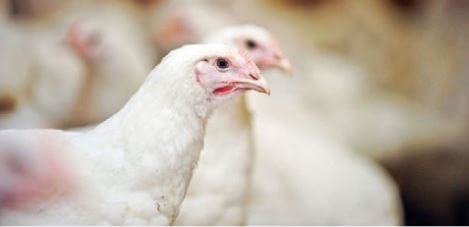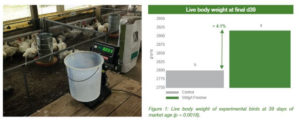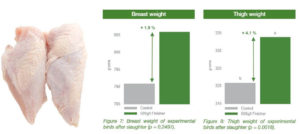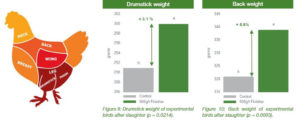
21 Jun ELIFE® supplementation in pre-slaughter diet improves zootechnical performance and slaughter yield parameters of broiler chickens.
Posted at 13:11h
in
News
by Rani Soriano
AIM
- Broiler chickens typically face high levels of oxidative stress during the last weeks of fattening. This metabolic challenge affects the free radical (oxidative) status in all organs and other body tissues up to slaughter. Obviously, this can have a substantial impact on the antioxidant system of the bird, its body growth and the carcass characteristics (among other factors).
- The objective of this broiler trial was to evaluate the supplementation of ELIFE® (selected blend of natural extracts rich in highly anti-oxidative polyphenols) during this stressful pre-slaughter Focus was put on the bird’s zootechnical performance and the weight yield of carcass and different meat parts (valuable retail cuts).
MATERIALS AND METHODS
- The trial involved 720 Ross308 male broiler day-old chicks. The birds were vaccinated against Marek disease and Infectious Bronchitis.
- At the day of housing, all animals were allotted (on an equal weight basis) to 18 pens of each 40 chicks in a complete randomized design, where each such pen was considered an experimental unit (replicate), and allocated to one of the following treatments (each consisting of 9 replicates or in total 360 birds):

- Birds received 3 different mash feeds to fulfill the phase-specific nutrient requirements of the starter (d1-d14), grower (d15-d32) and finisher (d33-d39) period. The feed of each group was prepared in separate batches, and ELIFE® natural antioxidant was added in the finisher to the test groups according to its inclusion rate in Table 1. Animals had ad libitum access to feed and water throughout the entire trial.
- The ingredient composition and nutrient content of these corn-soy based mash feeds are shown in Table 2. Birds received a shuttle anticoccididial program: maduramicin-nicarbazin (MNGrow®) in starter, followed by salinomycin (Saligran®) in grower phase.

- 60 animals per treatment were transported to a commercial slaughter house for carcass dressing. For each treatment, these animals were selected based on body weight to represent the pens average weight.
- After the dressing procedure, the weight yields of different meat parts (valuable for marketing) were determined.
RESULTS
Zootechnical
- Birds supplemented with 500 g/t of ELIFE® showed a significantly (p = 0.018) higher live body weight at slaughter age, compared to control birds (Figure 1). On average, ELIFE® fed birds were 116 g heavier to market than non-supplemented birds.
- In line with final live weight, birds fed ELIFE® had a numerically higher average daily weight gain(p=0.092) and average daily feed intake(p=0.0971) during the finisher supplementation phase (Figure 2-3). This resulted in a numerically improved (-0.04) Feed Conversion Ratio for the finisher period (Figure 4)


Weight yields after slaughter (whole carcass and valuable meat parts)
- The higher final body weight of ELIFE® treated animals resulted in a significantly (p=0.0001) heavier warm carcass weight compared to control animals (Figure 5). On average, ELIFE® fed birds generated an 81 g heavier carcass weight in the slaughterhouse than non-supplemented birds.
- Overall, supplementing ELIFE® created a 0.6% Higher carcass yield (i.e. warm carcass weight relative to fasted live weight of the birds after transport to slaughter unit). This dressing % is shown in Figure 6.
- For the collaborating commercial slaughterhouse, these carcass improvements imply an important economic benefit, given the large industrial scale they usually operate at in daily practice

- The results for absolute weight yield of breast muscle were obtained for all experimental groups and are shown in Figure 7. Birds supplemented on ELIFE® showed a numerically heavier breast muscle weight versus control animals.
- The higher carcass weight of ELIFE® fed birds also resulted in a significantly heavier absolute weight yields of the thigh (p=0.0018), drumstick (p=0.0214), back (p=0.0003) and head-neck (p=0.0025) meat cuts which are valued in the local retail meat market (Figure 8-10)















Sorry, the comment form is closed at this time.